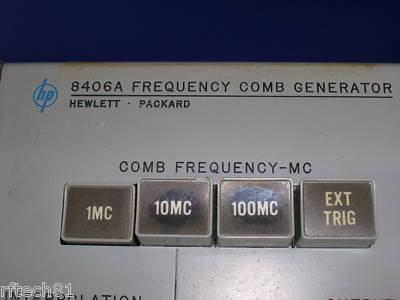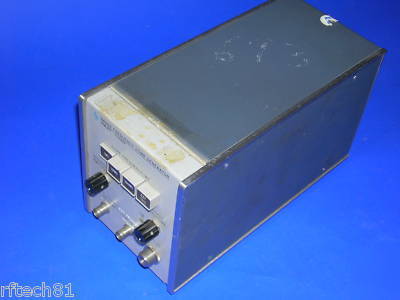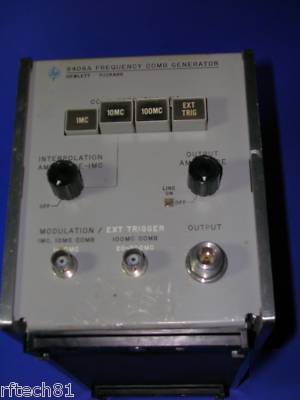Wisconsin Parts Database Instructions and Discussion Team/Group > OTHER STATES
> Electrical Components
> Add
> New
> Agilent / hp 8406A comb generator
Agilent / hp 8406A comb generator
Older COMB Generator that worked fine when it was last used by me some years back. It will need to be thoughly gone over before being used, and will need to be re-calibrated.
As you can tell by the logo this is a very old, and one of the very first models made by HP.
1-2. The hp Model 8406A supplies a frequency comb with a selectable spectral line spacing of 1 Mc, 10 Mc, 100Mc, or the frequency of an external trigger signal. The frequency comb generated is usable to at least 4 Gc. 1-3. The Model 8406A provides these additional features: a. Output level is continuously variable by a front panel control. b. Interpolation amplitude level is continuously variable by a front panel control. c. Comb frequency or external trigger frequency is selectable by front panel pushbuttons. This switch will not permit more than one button to be actuated at a time to avoid confusion in the output signal. d. Front panel BNC jacks are provided for modulation and external trigger frequencies. e. A switch is provided on the rear apron to switch the instrument to 230-volt operation.
OUTPUT AMPLITUDE control permits continuous level adjustment. Comb Output Connector: Type N female, source impedance approximately 50 ohm. Maximum External Signal at Comb Output: Signals exceeding 1 watt (pk and av) may cause damage. Interpolation Function: 10- Mc and 1-Mc combs can be combined into primary- secondary comb; Interpolation Amplitude control adjusts level of secondary (1 Mc) signal. External Modulation: External modulation signals can be used to phase modulate any of the combs to produce sidebands for interpolation between fixed comb markersl. BNC female connector. External Trigger: External signals (normally sine waves) between 1 Mc and 200 Mc can be used to produce combs spaced at frequency of trigger signals2. BNC female connector.
External modulation: Modulation frequencies can be as low as 5 kc. Although the level of modulation voltage required varies with modulating frequency and the harmonic number of the comb being modulated, the information here will serve as a guide: To produce sidebands approximately 20 db below the main comb marker at the 1 Gc harmonic of the appropriate comb (comb output amplitude at maximum), typical modulation voltages are: 1-2 mv rms at 200 kc for the 1 Mc comb 5-10 mv rms at 2 Mc for the 10 Mc comb 50-100 mv rms at 20 Mc for the 100 Mc comb Signals greater than 5v rms at modulation input may cause damage.
External Trigger: Typical input signal levels to generate externally triggered combs at the frequency of the external trigger are in the range of 1-3 volts rms. Input signals greater than 5 volts rms may cause damage. With input triggers in the 1-20 Mc frequency span, the OUTPUT AMPLITUDE control of the 8406A can be used to adjust the output comb level. When using signals in the frequency span from 20-200 Mc, output comb amplitude is a function of the input signal level.
3-1. INTRODUCTION. 3-2. The Model 8406 Frequency Comb Generator is used to calibrate other instruments which display the frequency domain. It is usually used with Spectrum Analyzers to calibrate their frequency and output characteristics. The illustration on the facing page, Figure 3-1, shows in general the operation of the Model 8406. The following paragraphs discuss special points which are not covered in the general explanation. 3-3. INTERPOLATION MODULATION. Usually to calibrate an instrument, the 10-Mccomb is used first to determine which lines correspond to the 10-Mc markers. If a finer determination is required, the INTERPOLATION AMPLITUDE control is turned on and the amplitude adjusted. This will give ten times more lines, each marking a 1-Mc point, in addition to the 10-Mc lines. If the 1-Mc Oscillator only were used, the same accuracy would be obtained but there is the possibility that a wrong line would be chosen if the instrument being tested is badly out of calibration. 3-4. EXTERNAL MODULATION. If a modulation spectrum other than 1 Mc on the internally generated comb is desired, feed the output from an external oscillator into the appropriate MODULATION jack (1 Mc and 10 Mc or 100 Mc COMB). The level should be adjustable around 10 millivolts. Depress the COMB FREQUENCY pushbutton for the main frequency spectrum desired. The output will now contain major spectrallines spaced at the frequency of the external oscillator. 3-5. FREQUENCY CONSIDERATIONS. At low levels of modulation (phase modulation), a single pair of side- bands appear - variable with modulation for precise frequency determination. At higher levels of modulation more sidebands appear which permit calibration of devices (spectrum analyzers, frequency meters. etc.) in arbitrary frequency increments. As with all modulation, the absolute accuracy of the generator must be increased by the multiple of the harmonic used in order to obtain the required accuracy at the operating frequency (the percentage accuracy is the same for all harmonics). 3-6. EXTERNAL TRIGGER. The external trigger voltage is fed in by means of the EXT TRIGGER jacks, either 1- 20 Mc or 20- 200 Mc, depending upon frequency. The signal used for external triggering should be ad- justable in amplitude around 2 volts. Note that in the EXTernal TRIGger position the OUTPUT AMPLITUDE control is operable when the signal is fed into the 1-20 MC EXT TRIGGER jack. The OUTPUT AMPLITUDE control may be used to adjust the output level when this jack is used. If the 20-200 Mc jack is used, the output level must be adjusted by varying the input level of the external trigger signal. The input from this jack does not go through the Diode Driver and therefore the OUTPUT AMPLITUDE control will have no effect. In fact, the instrument does not even have to be on if the 20-200 Mc jack is used. However, more power is needed (10-20 millivolts).





